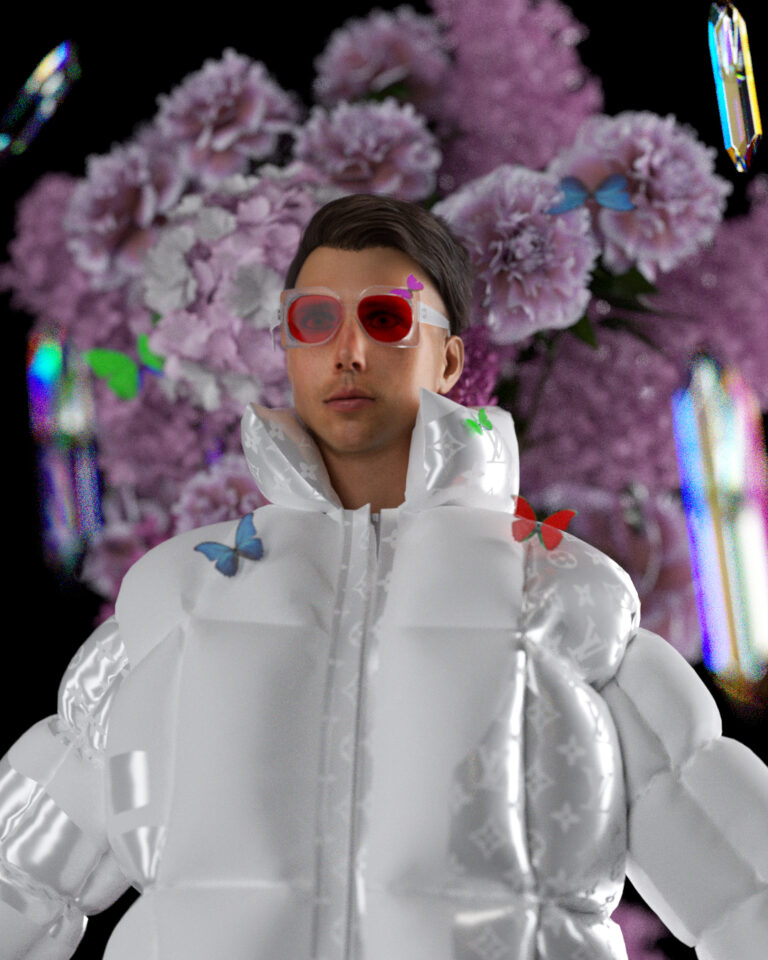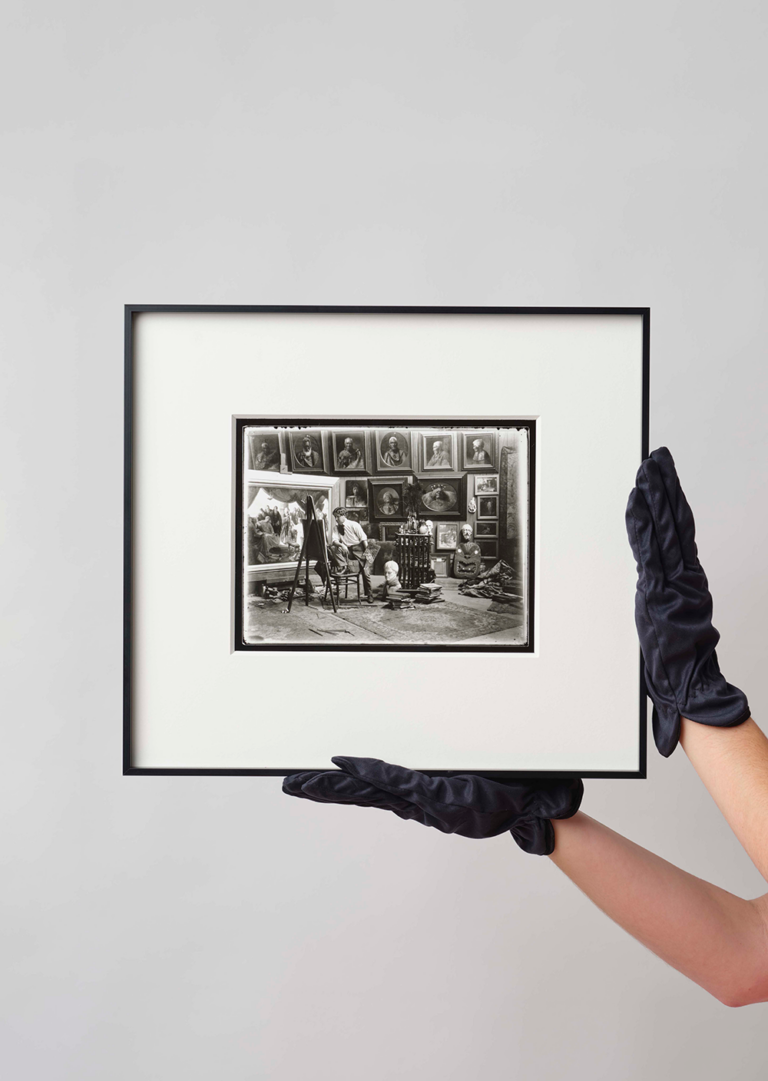
All it took was the rebrand of the world’s largest tech conglomerate to set the world abuzz. At Facebook Connect last October, Mark Zuckerberg announced the rebrand of Facebook Inc. to Meta, while presenting future plans for the network: a pseudo-interpretation of social technology reimagined for the Web 3.0 — for the next iteration of the world wide web and the metaverse.
On screen, a digital world unfolded — 3D model blocking panning to reveal a futuristic at-home entertainment room complete with a 360° view of snow-topped trees. The video toured through the halls of the virtual house to a sitting room, where Zuckerberg was superimposed in front of a floating fireplace and tropical sea views. Without as much as a single click, the time of day and seasons changed, and he was called to a meeting. But first, he needed something to wear.
A cartoon-like Zuckerberg avatar appeared before him and with the flick of his wrist, the social media magnate swiped through various head-to-toe looks. It was a digital wardrobe of sorts, and although not fashionable in the slightest, it was a small insight into how Zuckerberg believed we might soon ‘live’ in the metaverse.
Zuckerberg swiped through a T-shirt, jeans and sneakers, a skeleton onesie, and an astronaut’s space suit before settling on a replica of what his real-life persona was wearing: a navy crew-neck, long-sleeved tee, black pants and white sneakers. If his digital dressing is giving you a feeling of déjà vu, you’re not alone. You may recall Alicia Silverstone as Clueless’ Cher Horowitz parading around in her candy-striped bedroom, head bopping to David Bowie’s Fashion. It was 1995, yet teen queen Cher was well beyond the cutting edge of digital fashion, selecting her day’s outfit via her desktop PC, swiping through mismatches until she reached the iconic yellow plaid two-piece. It was a match, and the computer screen loaded a miniature like-for-like avatar of herself wearing the full ensemble, complete with a co-ord cardi, white tee, knee-high socks and Mary-Jane pumps.
There have been a number of tech ventures that have attempted to emulate this intuitive wardrobe software over the past two decades — Swivel, Metail and Whering, to name a few — yet there’s still a way to go when it comes to personalised mix-and-match algorithms like the technology observed in Clueless. But as for digital fashion itself? It’s a not-so-new concept.
Ahead of the game

The esports and video game industry has created virtual clothing for game avatars for a while now, and in recent years has proven that there’s a lucrative market to be found in digital clothing. Forbes reported that in November and December 2020 alone, Fortnite (dubbed the world’s most popular video game) sold 3.3 million NFL-branded ‘skins’ (otherwise known as digital outfits) for game avatars at an estimated total of US$50 million.
Luxury fashion houses have also made their mark on the esports world, with Louis Vuitton lending its esteemed monogram to a League of Legends collaboration in 2019. Gucci replicated its sportswear for the players of Tennis Clash in June last year, and launched a limited-edition range of accessories in a virtual Gucci Garden on Roblox.
Then there are Marc Jacobs’ and Valentino’s debuts on Animal Crossing: New Horizons, among others. Although they’re only for in-game use, these virtual purchases gave rise to a new era of digital products with endless capabilities that transcend beyond the limits of a single game: the NFT.
Intangible & non-fungible

Non-fungible tokens (NFTs) are unique and irreplaceable digital products created for the virtual world, backed by blockchain technology and obtainable only via cryptocurrency. They’re certified authentic, complete with the provenance you might receive when buying a collectible artwork from an auction house, and often one-of-one. Ownership can be transferred, with each transaction returning a portion of the purchase fee to the original creator. The actual product itself can range from an aforementioned digital outfit for a virtual avatar, to a digitally rendered artwork or even an authenticated tweet — the possibilities are endless.
On home soil, renowned auction house Webb’s made headlines for the sale of its first NFTs — the first by a major auction house in New Zealand. The decision to move into the digital space was made, as Webb’s General Manager Christine Kearney explains, to meet client demand.
“We pride ourselves on being at the forefront of innovation and are always eager to tackle new challenges — NFTs were an exciting prospect on this front,” she says. “Along with that, our clients had made it clear that they wanted to see high-quality NFTs up for auction… It was important for us to meet that demand.”
That demand was most certainly met, with the two NFTs — unique digital assets derived from original glass-plate negatives of two photographs of celebrated Aotearoa artist Charles Frederick Goldie — fetching $52,787.50 and $78,537.50 respectively at auction earlier this year. Alongside the digital asset, the top bidder also took home a framed print, as well as the original physical glass-plate negative.
Although traditional NFTs might not be sold with a tangible object, Kearney believes in a future in which digital and physical luxury co-exist — and the demand is there. “It seems that New Zealanders are interested in adopting this kind of [digital] future, but in a way that suits our own interests and cultural environment,” she says. “It’ll be fascinating to see how it all unfolds.”
Crypto clothing

Internationally, the world’s first fashion NFT, Iridescence, was auctioned in 2019 — a sheer, liquid-like, metallic digital dress that fetched a jaw-dropping US$9500. Created by digital fashion house The Fabricant in conjunction with artist Johanna Jaskowska and digital producer Dapper Labs, it represented a turning point in digital couture, proving there was crazy demand for out-of-this-world virtual fashion.
Speaking to the concept of the design, The Fabricant creative director Amber Jae Slooten sees this work as a glimpse into the future. “What can a body be when it is freed from physical restraints?” she asks, and the answer seems to lie within the metaverse, where creativity knows no boundaries. A digital garment can fit beyond the parameters of what we know and understand to exist physically, and no longer are textiles, and body shapes and sizes — not to mention the law of physics — the constraints by which designers have to abide.
For creative director Blue Hamel, otherwise known as his social-media moniker Half of Nothing, the digital world has opened up a slew of opportunities for content creation and connection with new audiences. “[The metaverse] is bringing to life things that you can’t do in the physical world yet… and with 3D [digital] fashion, I can tie fashion and content together in a way that’s interesting and new — in a way where I can wear any garment in the world that I want,” says the New Zealand-born, LA-based creative.
Hamel has been working with 3D design since 2017, and as an early adopter of digital fashion, sold his first NFT in collaboration with Crypto Fashion Week at the event’s debut last February. But it’s not only NFTs that he’s passionate about — it’s the open-source nature of digital creativity, where he’s not bound to a sewing machine or the use of pattern blocks to physically create a look. This, he says, can apply to the physical fashion industry too.
“There are endless capabilities… We don’t have to be doing hundreds and hundreds of different [physical] samples — you can actually just do one, match it in 3D, and put it on all different body types to see how it sits and how it flows,” he says. “It’s such an open game —it’s going to bring people in from all different spaces, people who never thought they could be a fashion designer, and now they can.”
Future focus
New Zealand’s Jessie Wong leads her luxury leather goods brand, Yu Mei, with a digital-first approach. Like many local and international designers, Covid was the catalyst for replicating Yu Mei’s physical events for the online world. The brand’s annual Archive event was hosted online for the first time in 2021 and attracted an audience of 11,000 shoppers; this year, that audience tripled to 30,000. “It’s mind-blowing to me,” says Wong. “From that I guess we understood that people wanted to engage with us in a much larger way than we’d ever been able to host physically before.”
A leader of the local fashion set, Yu Mei was the first homegrown brand to launch a digital runway presentation that was more than just a pre-recorded show. Its community, Club Yu Mei, was treated to a visual presentation of the label’s Summer 21-22 collection, with the ability to shop each product in real time with the click of a mouse. As each model sashayed down the purpose-built runway on the sandy shores of Wellington’s Breaker Bay, the frame was overlaid with an interactive feature — a product shot of the featured bag and a direct link that enabled viewers to shop now.
It’s a natural progression for Wong to explore the depths of digital’s capabilities when it comes to Yu Mei, but it has to be right for her customer. “We’ve talked a lot about having a digital product, NFTs, the metaverse and all that stuff, but what’s the real application for fashion?” she asks. “I know that there’s digital clothing and there are things that are applicable to the gaming universe, but in the world I live in and that the customers we have at the moment can associate with, what’s important?”
What’s important, and what has caught Wong’s attention, is the blockchain’s ability to hold provenance. It’s important at all stages of a Yu Mei bag’s life cycle — from the sourcing of the South Island deer nappa it’s crafted from, to the initial customer purchase, the brand’s buyback initiative, the carbon journey the bag has been on and beyond — and even more so when it comes to authenticity, and to back up the integrity of the brand’s supply chain.
It’s both verification and a storytelling tool, says Wong, which is a focus for Club Yu Mei in her physical and her digital spaces. “We want to continue building chapters in a book that will go between the physical and digital worlds… [an] omnichannel experience for everyone,” she says.
Perhaps, then, it’s the fostering and building of community that’s one of the great attractions of the growing digital world. Elizabeth Smith, artist and brand manager of NFT studio and marketplace Glorious, agrees. The first-of-its-kind platform, backed by sporting legend Dan Carter, is about to launch with one very straightforward purpose: “to create and present digital masterpieces that bring creators and collectors closer together,” says Smith, brimming with pride.
Much like Wong’s, Glorious’ emphasis is on building communities, breaking down barriers to entry and engaging with their audience at a level that might not be possible in the real world, through art. “[These art forms] make you feel something, and being able to allow that to be accessible is so important, ” says Smith. “We’re working with luxury products, but by no means are we going to be inaccessible.”
With accessibility and community at the forefront of the digital space, it’s fair to say that digital assets promote much more substance than meets the eye. Fashion and art have long presented themselves as cultural stamps and markers of time, determined by societal shifts and observed in real form. Tangible, yes, but if we allow ourselves to embrace the technology that is the metaverse, we just might find that the tangible and intangible can co-exist in harmony — and that the concept of purchasing pixels over thread is no longer a dream from a ’90s movie scene. And as for physical clothes alone? Well, we still have to get dressed every day, don’t we?










